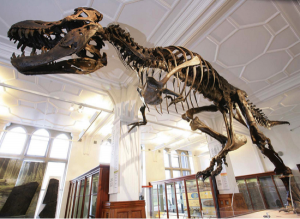The Manchester Museum
The Manchester Museum is part of The University of Manchester. It has a distinctive role in engaging the public with the work of the University. The Museum has the third largest natural sciences collection in the UK, with 4.5 million specimens, from birds and plants collected by Charles Darwin to specimens of new species collected and classified by present curators. Many of the collections can be searched from the Museum’s website (www.museum.manchester.ac.uk). There are also numerous additional resources, such as library materials and associated archives. The Museum has around 500,000 visits per year and over 20,000 visits by schoolchildren.
- Museum staff work to make the collection available for teaching, research and public engagement and are always keen to explore new opportunities to engage students with the collection. Many museum staff teach on lecture courses and field courses, practicals and research skills modules. They also offer a number of studying opportunities, including final year projects, industrial placements, use of the Museum resources in PhD and Post-Doctoral work and co-supervision of PhDs. These may involve the collections or the specialist interests of staff. You are encouraged to contact museum staff to self-arrange projects.
- The Museum is heavily involved in local biodiversity, climate change and sustainability work and helps to deliver the Biodiversity Action Plan and Climate Change Action Plan (A Certain Future) for Manchester.
- The Museum can help you develop employability through its many volunteering opportunities, particularly useful to those who wish to enter careers in public communication, education and, of course, museums.
- Anyone—staff or student—can visit collections that are not on display. This is done by arranging a visit with the appropriate curator (details below) or by arranging to visit the Collections Study Centre. The collections are a wonderful source of inspiration and information for research on scientific subjects and the history of science.
- Entry to the Museum is free. It has fantastic galleries and a busy programme of temporary exhibitions and public events. The museum café is a popular meeting place for both students and staff.
Zoology: internationally important collections of many groups of animals, particularly birds, mammals, skeletons, molluscs and many other invertebrates, around 250,000 specimens. Contact Henry McGhie, Head of Collections and Curator of Zoology, who has a particular interest in bird biology and ecology, email: henry.mcghie@manchester.ac.uk.
Botany: an internationally important collection of over one million specimens of worldwide plants, mostly herbarium sheets. Contact Rachel Webster (email: Rachel.E.Webster@manchester.ac.uk), Curator of Botany.
Entomology: internationally important collections of over two million insects from most taxonomic groups. Contact Dmitri Logunov, Curator of Arthropods, who has a particular interest in spiders, email: dmitri.v.logunov@manchester.ac.uk.
Earth Sciences: one of the five regional Earth Science Collection centres in the UK; one of the largest mineral collections with over 30,000 specimens and important collections of fossil plants and animals, with over 100,000 specimens. Contact David Gelsthorpe, Curator of Earth Sciences, email: david.gelsthorpe@manchester.ac.uk.
Vivarium: a unique collection of live animals with over 270 specimens of 40 species. Contact Andrew Gray, Curator of Herpetology, who has a particular interest in tropical frogs, email: andrew.r.gray@manchester.ac.uk.
Also humanities collections, notably an important Egyptology collection and Archaeology collection.
To book a visit to the museum Collections Study Centre, telephone 0161 275 2643 or email museum@manchester.ac.uk.

